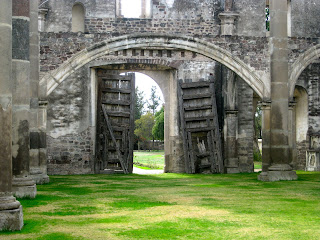The last week of school, we went to visit a talavera factory, called Uriarte. It was founded in 1824, and is still run by the same family. Talavera is the colorful pottery made in Puebla, and the real thing is made by quite an interesting process.

This is the indoor courtyard of the workshop.

Isn't this fountain-shrine pretty?

This is the big old oven. It isn't in use anymore.

This is a big giant mold for a big giant vase.

This is the pot that comes out of that mold. Mighty big.

This is a giant grinder where they grand the colors for the pottery.

This is a guy making a bowl.

Here are some little tiny bowls being made.

These are logs of clay... pre-pot.

Broken trash. They sell this to make broken tile masterpieces.

Here is how the clay dries.

This is slipping through the first glaze.

Here is an artist painting the pottery. A charcoal pattern is put on first, then vegetable colors area applied. The traditional colors are dark blue, light blue, orange, yellow, black and green.

Here is what it looks like before it is fired. All genuine talavera has a D04 on the back of it, and should be done in the traditional colors.

Here are Teah and Becky after the tour!



 This is a nun's cell. Note the self-mortification devices.
This is a nun's cell. Note the self-mortification devices.
 This is the room where the hidden convent was discovered. After 34 years of hiding.
This is the room where the hidden convent was discovered. After 34 years of hiding. This is the way down to the crypt.
This is the way down to the crypt. Kitchen.
Kitchen. Pottery.
Pottery. More pottery.
More pottery.











































